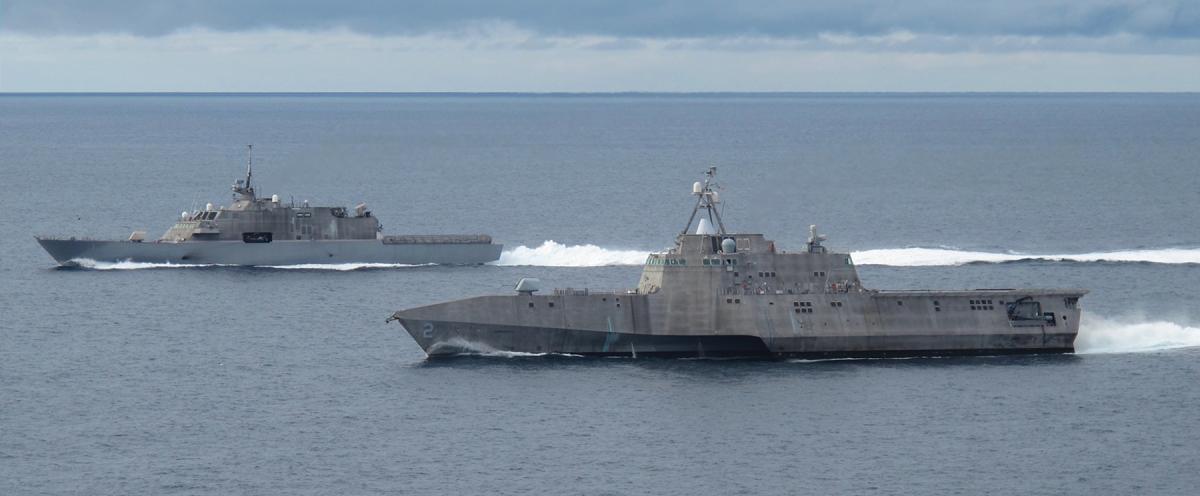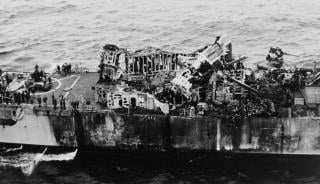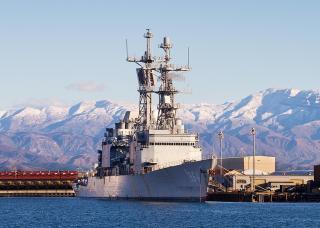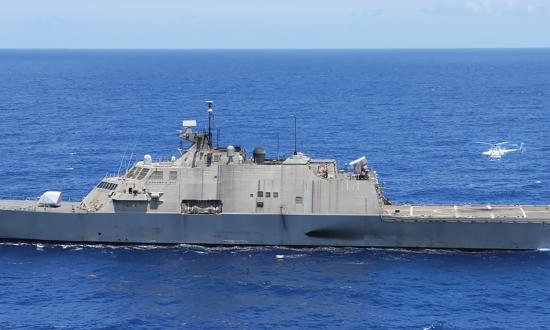After more than a decade of development delays, the littoral combat ship (LCS) is showing some usefulness in the fleet. But despite this progress, it remains a troubled program. The program is a favorite punching bag when it comes to examples of waste and failure. Therefore, what I am about to say is neither bold nor new: LCS is a drain on the surface fleet and should be terminated immediately.
Now that the Constellation-class frigates will be coming down the slipways, LCS has lost its reason for being. It has failed to live up to expectations; been a burden in terms of money, material, and manning; and can serve no purpose in retirement.
Scrap all LCSs now.
Promise vs. Reality
The LCS program was envisioned as providing low-end capability balanced by the highly capable DD(X) and CG(X).1 Its design called for 40 knots in seas up to 5.9 feet, 1,000 nautical mile (nm) endurance at 40 knots, 3,500 nm endurance at 18 knots, a core crew of 50 personnel, 25 personnel for mission package detachment, and swappable antisurface warfare (ASUW), antisubmarine warfare (ASW), and mine warfare (MIW) modules. The ability to rapidly reconfigure an LCS for different missions using “modular mission packages” was a central feature to the design and a key selling point.2
Currently, the Freedom variant has demonstrated a sprint speed of 38.7 knots and a roughly 3,880 nm endurance at 14 knots, and the Independence variant has demonstrated a sprint speed of 41.4 knots and 6,040 nm endurance at 14 knots.3 Caution must be exercised when reading these endurance figures, however, because the ships seldom let their fuel state fall below 60 or 70 percent.4 A normal operating range—burning 40 percent of fuel—for the Freedom variant would be roughly 1,550 nm, while the Independence variant can travel some 2,420 nm. In wartime steaming, the 60 to 70 percent rule may be forgone in favor of extending the range.
Both variants have forgone swappable mission modules and mission package detachments, combining the detachment personnel with the base crew for a total of 70 personnel per crew.5 Plus, they carry an additional 24 personnel when they embark an air detachment, bringing the total crew to 94.6
These capabilities have thus far taken the Freedom variant 14 years and the Independence variant 12 years to accomplish.
The Office of the Director, Operational Test and Evaluation’s fiscal year 2015 (FY15) Navy Programs summary for LCS casts doubt on the endurance of both variants. During 2015 trials, the USS Fort Worth (LCS-3) demonstrated performance correlating to a range of 1,960 nm at 14 knots and 855 nm at 43.6 knots. The USS Coronado (LCS-4, now decommissioned) was able to demonstrate a fuel endurance of 5,345 nm at 14 knots based on a six-hour trial. The summary further states that if a 20-percent fuel buffer were maintained, the ship’s endurance would be 4,242 nm. For the sprint trial, the Coronado was able to maintain 37.9 knots for three hours with a predicted endurance of 1,000 nm using the “practically available fuel.” However, she had difficulty maintaining sprint speed because of various challenges with the engineering plant.7
If we accept that LCS has come a long way since 2015, we still have to reckon with the problem of on-station time. The practical range of these ships—burning no more than 30–40 percent of their maximum fuel load—severely hampers their ability to conduct any of their limited warfare missions. To get around the western Pacific region, an LCS would have to travel anywhere from 1,326 nm (Singapore to Subic Bay) to 2,883 nm (Singapore to Yokosuka). Both variants technically can complete one-way transits without stopping, but they cannot make the journey back without replenishment.
Recently, the troubled ASW mission module for LCS was canceled for cost overruns.8 With the cancellation, LCS is down to just the ASUW mission module; initial operating capability for the MIW module is due this fall.9 While the MIW module includes many technologies, most can be employed from other surface combatants. LCS also was not designed to conduct area air defense.
Because LCS is unable to fulfill almost any major warfare capabilities, it continues to be a platform in search of a mission.
Something not commonly discussed regarding LCS is their survivability. The Independence variants have aluminum hulls. The 1975 collision of the aircraft carrier USS John F. Kennedy (CV-67) and guided-missile cruiser Belknap (CG-26) showed the Navy the danger of aluminum on warships—when the resulting fire melted the aluminum superstructure on the Belknap.10 This is not to say aluminum should never be used, but it does come with increased risk to the crew and mission in the event of a fire. In addition, there are the issues of hull cracking and galvanic corrosion.
LCS is showing that it cannot survive normal operational stresses let alone the stresses that may be imposed by battle damage.
The Cost of LCS
According to the Government Accountability Office (GAO), the LCS program will cost more than $60 billion for the 35 planned ships and 44 mission modules.11 Notably, this estimate does not include the unplanned repairs for several design defects in each variant. Of the 35 ships, the Navy is planning to retain just 21—15 MCM ships of the Independence variant and 6 ASUW ships of the Freedom variant.12
The 15 MCM variants will be a much-belated replacement for the Avenger-class MCM ships, but their high annual operational costs—$50-70 million, compared to $81 million for an Arleigh Burke–class destroyer—seem exorbitant for a ship type that does not perform many missions.13 The reason for the high cost is an overdependence on shore-based maintenance. Contracts for maintenance are in the range of $72.5 million (with options, up to $215.9 million) and $344.7 million.14 Compounding this expense is the need to transport contractors and equipment overseas to these ships. The weakness in this maintenance strategy was noticed by the program manager, Ships 505, who oversees the fleet introduction and sustainment of LCS: “When the bullets start flying . . . I can’t wait to send somebody out there. I need somebody there now.”15
The current crew configuration for the LCS is set to change radically. In place of the twin core crews of 70 personnel, the remaining Freedom variants will have single crews with 25 more sailors to help maintain readiness.16 This means there will be 2,670 sailors serving on board LCSs—sailors who could instead crew 8.5 Arleigh Burke–class destroyers.
In response to the decrease in LCS fleet size and adjustments in crew size, the Navy plans on closing LCS Training Facility Atlantic and consolidating the training at LCS Training Facility Pacific. This will result in mothballing a $24.7 million training facility.17 If the Pacific facility and the Bridge Part-Task Trainers in Newport, Rhode Island, also were to be closed, that number would rise to $75.5 million.18 As bad as that sounds, the savings in instructor manning, student time, and operational expenses would be worth it. Instructors freed from teaching the LCS-related courses, such as the six-week LCS officer of the deck course, could fill instructor billets in other courses. The time spent in the numerous required courses for LCS crews—on the order of six months—could be spent in active service on board ships.
In 2020, Freedom variant ships began having issues with the combining gears that connect the diesel and gas turbine engines.Ships with this defect can achieve high speeds only by avoiding operating on both diesel and gas turbine engines, lowering their top speed slightly.19 Surprisingly, the Navy is continuing with the combining gear fix for the USS St. Louis (LCS-19), a vessel slated for decommissioning in FY23.20
Issues with aluminum structures on warships have been acknowledged as far back as 1987.21 Nevertheless, superstructure cracking was discovered on Freedom variant ships within four years of commissioning.Within a year of commissioning, the USS Independence (LCS-2) noted severe galvanic corrosion.22 The corrosion problem seemingly has been resolved, but a new aluminum-related problem has emerged in the Independence variant: hull cracking.As a result, Independence variants are restricted from transiting faster than 15 knots in a high sea state and cannot operate in seas greater than 8.2 feet.23 These restrictions can impair the ability of these ships to transit as they please, and they nullify any advantage speed would give these vessels in a fight.
A potential issue is cavitation in the waterjets that propel LCSs. The combination of the high-speed rotation of the impeller and the low pressure exerted by the water causes waterjets to cavitate, leading to erosion of surfaces that come in contact with cavitation bubbles. Eventually, erosion on the waterjet impellers will make them less effective at propelling the ship. It seems fair to assume the LCSs will need speed-limiting later in their service lives to prolong the lives of their waterjets.
Given all these issues and their costs, plus the LCS’s inability to perform major warfare functions, it is hard to imagine what value—aside from keeping shipyards open—the LCS has provided the Navy.
Repurpose and Retirement Ideas
Recent proposals have suggested how the Navy could use retired LCSs, including as a replacement for the Self-Defense Test Ship (SDTS), the ex-USS Paul F. Foster.24 However, an LCS does not have the same space or power reserve as the Paul F. Foster. The SDTS has four 2 megawatt generators, whereas the Freedom variant has four 800 kilowatt generators.25 Assuming the same power specifications for the Independence variant, an LCS has about as much power as one-and-a-half generators on board the SDTS.
A more suitable replacement would be a recently decommissioned Ticonderoga-class cruiser. The advantage of the Ticonderoga cruiser is that it contains similar systems to those used on other surface combatants, has more room for test equipment, and has more power than an LCS (7.5 MW total).26
Differences in ship systems also preclude LCSs from being an effective platform to ship-check new components or systems, and it would be a false representation of surface combatants to Officer Candidate School and Officer Development School students. Using LCSs as helicopter landing ships would be a good idea if they did not require a large support infrastructure for maintenance and training. A conventional ship that uses the same maintenance and training schemes as other surface combatants would do a better job. Again, a recently retired cruiser would perform these functions better than an LCS.
Considering the lack of useful employment for LCSs in retirement, the best option is to cannibalize them for parts. On board U.S. Navy ships, much equipment is generic. Common electrical switchgear, lighting fixtures, announcing systems, damage-control equipment, firefighting gear, pumps, motors, and other common engineering plant equipment all could be reused on other ships. Significantly, LCS cannibalization would include their main engines. The LM-2500s from the Independence variant could be used for new construction and repair of Arleigh Burke–class destroyers and the construction of Constellation-class frigates. The MT-30 engines from Freedom variants could be used for repairs to Zumwalt-class destroyers and as prime movers for the DDG(X), if selected.
End LCS Now
The LCS program has fallen short of its intended goals. Accordingly, the Navy has been trying to make do with whatever tasks LCSs can perform. This is the opposite of what it should be doing. Ships should fit a purpose, and the purpose of ships should fit into the vision of how the fleet fights. Given the LCS’s performance to date, there is no place for LCSs in the battle fleet and no space for LCSs on crowded piers.
It is time to put this troubled program out of its misery.
1. Robert O. Work, The Littoral Combat Ship: How We Got Here, and Why (Office of the Under Secretary of the Navy, Washington, DC: 2014).
2. Department of the Navy, Preliminary Design Interim Requirements Document for Littoral Combat Ship (LCS), Flight 0, Pre-ACAT (Washington, DC: 2003).
3. Department of the Navy, Littoral Combat Ship (LCS) December 2021 Selected Acquisition Report (Washington, DC: 2021).
4. Work, The Littoral Combat Ship: How We Got Here, and Why.
5. Office of the Director, Operational Test and Evaluation, Director, Operational Test and Evaluation FY 2016 Annual Report (Washington, DC: 2016).
6. Sam LaGrone, “Six Littoral Combat Ships to Deploy by Year’s End as Navy Continues to Refine Operations,” USNI News, 28 June 2021.
7. Office of the Director, Operational Test and Evaluation, Director, Operational Test and Evaluation FY 2015 Annual Report (Washington, DC: 2015).
8. Megan Eckstein, “Navy Effort to Cancel LCS Mission Package Triggers New Cost Breach,” Defense News, 13 May 2022.
9. Peter Ong, “Admiral Gilday Explains LCS ASW And MCM Module Decisions,” Naval News, 5 May 2022.
10. Ben Werner, “Navy Punishes Negligence at Sea But Rarely Secures Criminal Convictions,” USNI News, 22 January 2018.
11. Diana Maurer et al., Littoral Combat Ship: Actions Needed to Address Significant Operational Challenges and Implement Planned Sustainment Approach (Government Accountability Office, Washington, DC: 2022).
12. Richard R. Burgess, “Navy’s LCS Decommissioning Proposals Would Bring Major Changes for Retained Ships,” Seapower, 20 April 2022.
13. David B. Larter, “High Operating Costs Cloud the Future of Littoral Combat Ships, Budget Data Reveals,” Defense News, 12 April 2021.
14. Nichols Martin, “3 Shipyard Operators Win Spots on $345M Navy LCS Sustainment Contract,” GovCon Wire, 5 August 2021; and Austal Limited, “Austal USA Awarded US$72.5 Million Contract to Maintain LCS Deployed in Western Pacific, With Options to Increase to US$215.9 Million,” news release, 24 November 2021.
15. Justin Katz, “To Keep LCS Going, New Captain Sees ‘Sailor-Centric’ Self-reliance Strategy,” Breaking Defense, 18 January 2022.
16. Burgess, “Navy’s LCS Decommissioning Proposals.”
17. Naval Facilities Engineering Systems Command, “NAVFAC Southeast Awards $24.7 Million for New LCS Operational Trainer Facility at NS Mayport,” press release, 1 March 2019.
18. Mortenson, “Who Built the Facility to Train the Navy for the Littoral Combat Ship?” Mortenson.com; and “Indefinite Delivery/Indefinite Quantity (IDIQ) Contract PIID N6134012D5105,” USAspending.gov.
19. Geoff Ziezulewicz, “This LCS Just Completed an ‘Historic’ Deployment,” Navy Times, 5 October 2022.
20. Mallory Shelbourne, “Navy Moving Ahead on Combining Gear Fix on Freedom Littoral Combat Ships Marked for Decommissioning,” USNI News, 15 August 2022.
21. Associated Press, “Navy Virtually Abandons Aluminum Superstructures for New Ships,” Associated Press News, 21 July 1987.
22. Ron O’Rourke, Navy Littoral Combat Ship (LCS) Program: Background, Issues, and Options for Congress (Washington, DC: Congressional Research Service, 13 June 2012).
23. Geoff Ziezulewicz, “The Littoral Combat Ship’s Latest Problem: Class-wide Structural Defects Leading to Hull Cracks,” Navy Times, 10 May 2022.
24. LT Brian Adornato, USNR, “Retirement Jobs for the LCS,” U.S. Naval Institute Proceedings 148, no. 9 (September 2022).
25. Naval Sea Systems Command, “Naval Vessel Historical Evaluation,"; and Fincantieri, “Littoral Combat Ship—Freedom Class.”
26. Jeffrey S. Patterson, Donald J Hoffman, and Linda M. Ochs, Allison 501-K17 SSGTGs Technical Directive Experience (Orlando, FL: U.S. Naval Surface Warfare Center, Carderock Division 1997).








